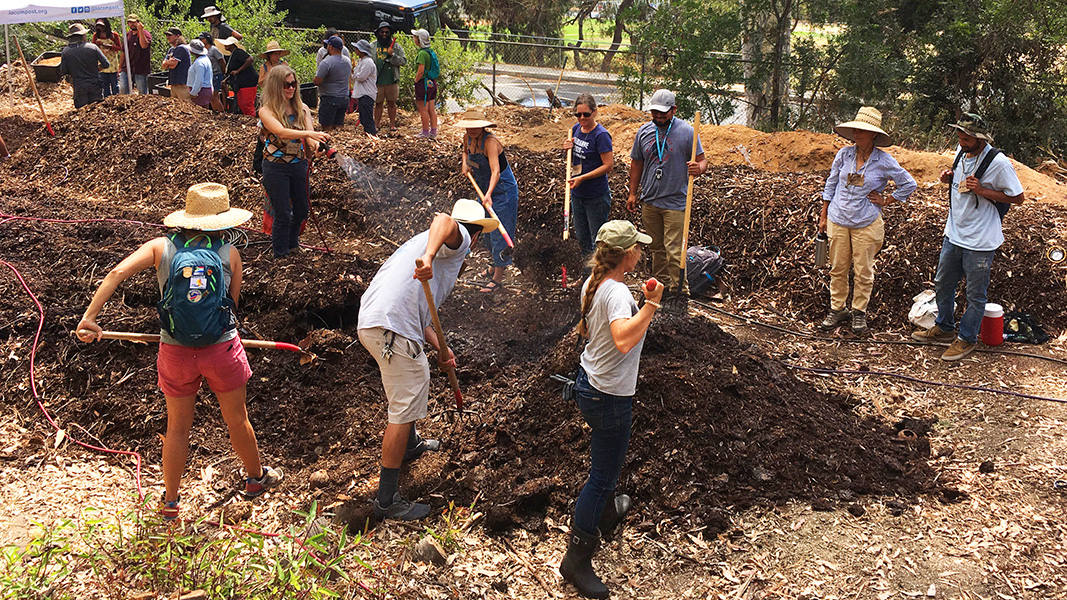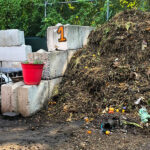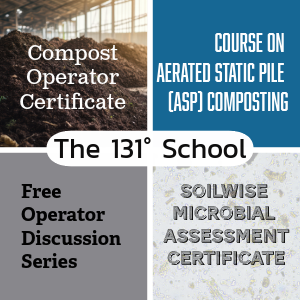Top: Windrow turning at Debs Regional Park compost hub in Los Angeles. Photo by Kourtnii Brown
Kourtnii Brown
The California Alliance for Community Composting (CACC) provides technical and financial assistance to 105 community-based organizations in six priority regions statewide that are participating in CalRecycle’s $1.54 million pilot grant program, “Community Composting for Greens Spaces” (CCGS). The current round of the program ends in March 2023, and CACC groups have collectively submitted $4.8 million in requests to CalRecycle for funds to coordinate the second round of the program (CCGS-2) that is scheduled to run April 2023-April 2025. CCGS creates local green jobs, improves local soil health for local food production, and supplements local capacity and knowledge to meet zero waste goals.
However, Governor Gavin Newsom’s 2023-24 Budget Summary released in January proposed a $4.8 million budget cut from the 2021-2022 General Fund within the Circular Economy package. This move puts this uniquely impactful program in jeopardy. Now is not the time for California to stall investments in low cost and community-based composting infrastructure development, especially because what California needs for SB 1383 to be most successful from the outset is continued public education and engagement on composting.
CACC has four main points to communicate to BioCycle readers about what this specific budget cut means for sustainable and equitable food systems in California at-large:
- Community composting is a well-performing and cost-effective Greenhouse Gas Reduction Fund (GGRF) program investment, which is directly supported by California taxpayer dollars.
- Community composting offers substantive social and environmental impacts in addition to landfill diversion capacity at half the cost of average commercial composting operations in California.
- Demand for community compost hubs is oversubscribed and underfunded in all major California urban areas.
- A state funding gap threatens community composting’s momentum to scale at a time when California needs diversion capacity to stay on target with meeting landfill diversion goals and implementing Senate Bill 1383 (SB 1383).
The implications this specific budget decision will have on the work of CalRecycle, CACC as an umbrella organization, the 105 organizations we currently support, the 115 future compost hubs we plan to launch under CCGS-2, and the myriad of environmental, social and economic benefits that our local composting projects provide needs to be understood. CCGS exemplifies the future of the circular economy and achieving organic material recovery and greenhouse gas (GHG) reduction goals that are rooted in principles of environmental and social justice. The California Senate Budget and Fiscal Review Committee has to continue investing $4.8 million in community composting, healthy soils, and priority communities through CalRecycle and CCGS, especially since these other climate-related areas have similarly experienced an additional $350 million in total proposed budget cuts. Impacted programs include climate smart agriculture and healthy soils (-$94.2M), urban greening (-$100M), equitable food systems (-$29.5M), and regional climate resilience (-$125M). Defunding all these related programs simultaneously sends the message that California does not honor the progress that priority communities have collectively contributed toward building California’s climate resilience and contradicts strong climate commitments the state has made in the realm of resource recovery.
Community Compost Grant Benefits
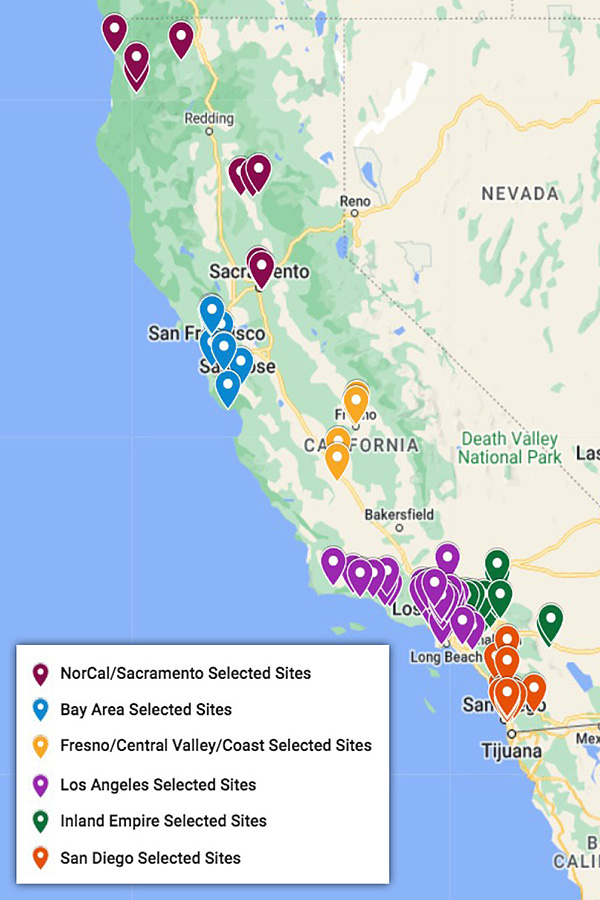
CCGS project sites are all either located in or directly serve disadvantaged or low-income communities. They are composting primarily material generated by local residents or on-site. ©Google My Maps
In 2022, CACC spent $685,000 supporting 105 community groups across the state of California — all either located in or directly serving disadvantaged or low-income communities. Current CCGS groups are heavily concentrated in the Southern California urban centers (see map) where there is the greatest priority need and highest population density. The sites are located primarily at urban gardens and farms, but are also present at schools, community centers, food banks, public parks, and on tribal lands. They are composting primarily material generated by local residents or on-site, but a handful of project groups are also working with local businesses and food recovery organizations to divert material locally. Feedstocks accepted are limited based on site location and/or composting method.
Collectively, 3,375 tons of organics are diverted through the 120 small compost hubs that launched or expanded as part of CCGS. The average operations cost last year for labor and infrastructure was only $200/ton of organic material diverted, which is far below the industry average for commercial composting facilities at $373/ton. This competitive price point for organics diversion was accomplished with more than half of the labor hours spent doing other related compost activities, such as farming, urban greening, habitat conservation, food distribution, and educating the public about healthy compost and healthy soils.
Through CCGS, CACC has demonstrated that community composting is the most affordable and efficient option for creating landfill diversion capacity and that educating the public about proper source separation is one of the most cost-effective methods for both decreasing preprocessing costs and increasing overall diversion rates. California is not on target to divert 26.8 million tons of organics annually to reach 75% reduction by 2025. Gov. Newsom’s budget choice will contribute to further delays in that possibility.
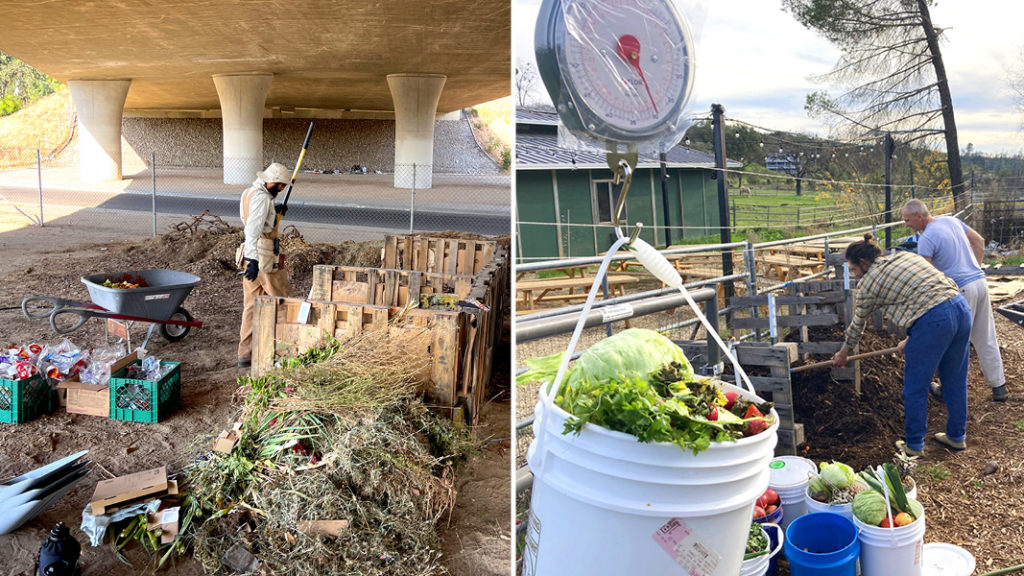
Fresno Metro Ministry Lowell Garden, under a highway bridge (left), photo by Chris De Leon; Paradise Community Composting on a farm (right), photo by Janeva Sorenson
In addition to diversion metrics and program costs, it is critical to take a closer look at all the other co-benefits provided when composting is conducted through small-scale and decentralized networks. In 2022, CCGS supported part-time, well-paid jobs for 60 people to do this work on the ground locally. The majority of these positions are held by low-income and underrepresented individuals in historically underserved communities. We estimate that CCGS project sites collectively reduced emissions by 583 MTCO2e from diversion alone, with another 1,031 MTCO2e in reductions achieved by applying the 2,750 cubic yards of compost produced in 2022 on local gardens and farms, 369,000 MTCO2e by planting 59 trees, and an unknown amount of GHG emission reductions because of less vehicle miles traveled for conducting these operations. In addition, groups have reported distributing fresh produce grown on-site to food insecure residents, engaging thousands of volunteer hours in hands-on project activities, and hosting hundreds of public events to engage people with their compost hubs on a regular basis and learn about innovative methods to improve resource recovery and soil health in California.
CACC’s accomplishments this past year are significant in large part because the work happened at the same time cities across the state were working to come into SB 1383 compliance and looking for innovative models. The two largest obstacles for jurisdictions in terms of SB 1383 implementation and procurement are: Cost-prohibitiveness for collecting and processing organics using only large-scale, franchised service providers and their far away facilities, or by needing to provide collection and processing themselves with municipal infrastructure; and Decreased value of finished compost from curbside collection programs that is highly contaminated with microplastics. CCGS helps provide both affordable capacity and high-quality compost. CACC’s mission is directly in line with the state’s targets and works to make these targets more viable and attainable while also supporting low-income and disadvantaged communities.
In November 2022, CACC submitted grant proposals to CalRecycle to continue expanding community compost hubs into 2025. CalRecycle already publicly appropriated these funds in June 2022 specifically for CCGS-2. The agency is currently reviewing all regional proposal submissions and is expected to announce awards as early as March. CACC’s collective request of $4.8 million is the exact amount that the Administration has recently decided to cut. Many of our participating organizations are reliant on the next round of CCGS to attain their long-term financial sustainability. Many more are hopeful for the opportunity to join the program and launch new operations. We are all depending on CCGS-2 beginning as planned in April 2023. Cutting this program abruptly eliminates meaningful jobs from those who can least afford to lose them and offers little time for CACC and the organizations we support to pivot to other funders with seamless continuity to keep our work uninterrupted. Your help is needed to communicate to Californians that our ability to protect our progress to mitigate climate change and support our communities is at risk.
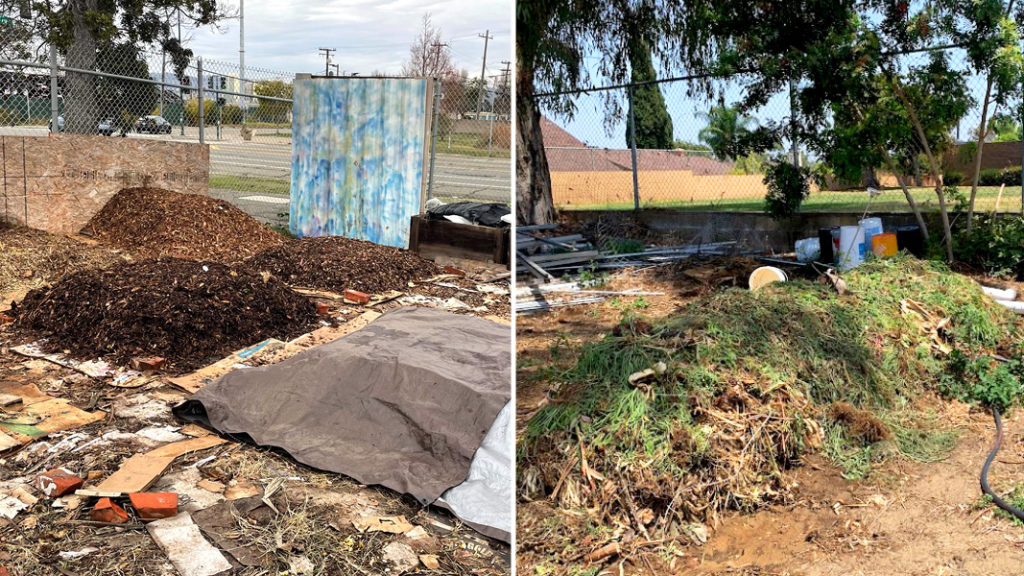
Alameda Point Collaborative site (left), photo by Kourtnii Brown; Community Roots Farm’s aerated static composting operation (right), photo by Tammy Bowser
Alternative Choices
There are several alternative choices that the Governor’s Administration and California State Legislature can make, in the following order:
- Seek state funding from the $198 million Greenhouse Gas Reduction Fund (GGRF) allocation for organics material recovery to offset this $4.8 million decrease in the Circular Economy package for community composting.
- Seek federal funding from the Inflation Reduction Act (IRA) and the Infrastructure Investment and Jobs Act (IIJA) to offset this $4.8 million decrease of General Funds like the Administration plans to do for other climate programs.
- At worst, delay the $4.8 million allocation under a “trigger reduction” to the 2024 General Fund so that this program remains fully funded and still possible next January.
Please help us get the word out that Gov. Newsom’s Administration is not honoring previous commitments to the Circular Economy package, among many other climate change investment programs (see Call to Action in sidebar). As such, both the Legislature and CalRecycle cannot fully embody the mission stated in the Governor’s Budget Summary “to prioritize equity and investments in priority populations, which face disproportionate harm from pollution and the climate crisis,” as well as maintain the values that “communities are at the center of California’s climate agenda” and “successfully building California’s circular economy will require innovative solutions and approaches to waste.” We share this mission and values, we’re doing this work, and we ask you to please stand with us.
Kourtnii Brown co-founded and serves on the Board of Directors for the California Alliance for Community Composting, which was awarded a $1.54 million grant from CalRecycle in 2020 to expand small-scale composting infrastructure and training in historically underserved communities throughout California. She also consults on compost policy initiatives for the Sustainable Economies Law Center and the Institute for Local Self Reliance, who collaborate to educate community composters and policymakers from around the country on how to shape inclusive and sustainable local compost rules and ordinances.


